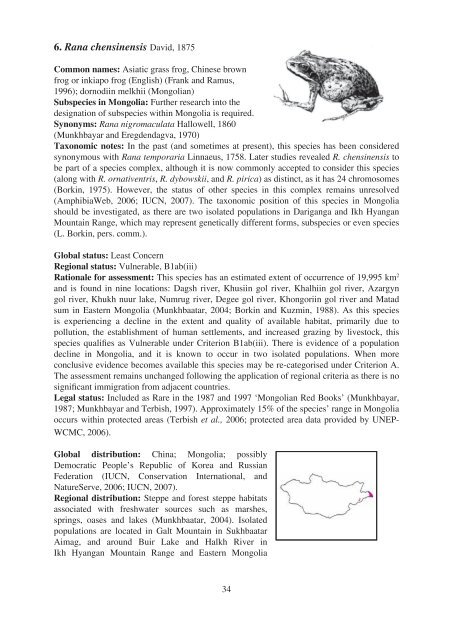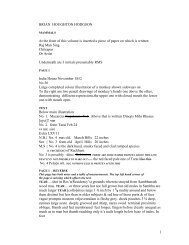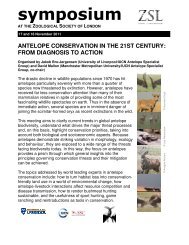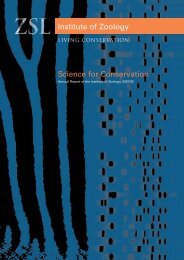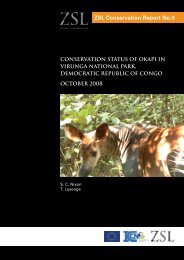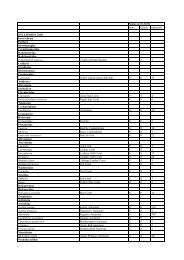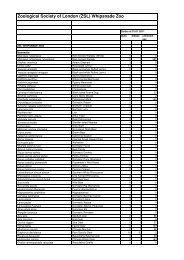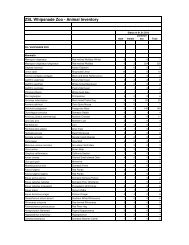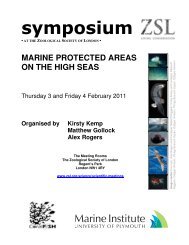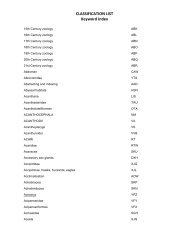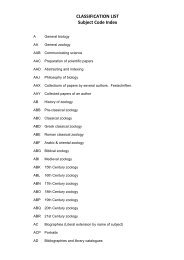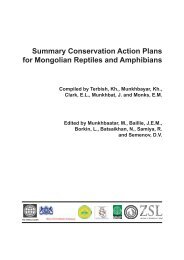Mongolian Red List of Reptiles and Amphibians - Web - Zoological ...
Mongolian Red List of Reptiles and Amphibians - Web - Zoological ...
Mongolian Red List of Reptiles and Amphibians - Web - Zoological ...
You also want an ePaper? Increase the reach of your titles
YUMPU automatically turns print PDFs into web optimized ePapers that Google loves.
6. Rana chensinensis David, 1875<br />
Common names: Asiatic grass frog, Chinese brown<br />
frog or inkiapo frog (English) (Frank <strong>and</strong> Ramus,<br />
1996); dornodiin melkhii (<strong>Mongolian</strong>)<br />
Subspecies in Mongolia: Further research into the<br />
designation <strong>of</strong> subspecies within Mongolia is required.<br />
Synonyms: Rana nigromaculata Hallowell, 1860<br />
(Munkhbayar <strong>and</strong> Eregdendagva, 1970)<br />
Taxonomic notes: In the past (<strong>and</strong> sometimes at present), this species has been considered<br />
synonymous with Rana temporaria Linnaeus, 1758. Later studies revealed R. chensinensis to<br />
be part <strong>of</strong> a species complex, although it is now commonly accepted to consider this species<br />
(along with R. ornativentris, R. dybowskii, <strong>and</strong> R. pirica) as distinct, as it has 24 chromosomes<br />
(Borkin, 1975). However, the status <strong>of</strong> other species in this complex remains unresolved<br />
(Amphibia<strong>Web</strong>, 2006; IUCN, 2007). The taxonomic position <strong>of</strong> this species in Mongolia<br />
should be investigated, as there are two isolated populations in Dariganga <strong>and</strong> Ikh Hyangan<br />
Mountain Range, which may represent genetically different forms, subspecies or even species<br />
(L. Borkin, pers. comm.).<br />
Global status: Least Concern<br />
Regional status: Vulnerable, B1ab(iii)<br />
Rationale for assessment: This species has an estimated extent <strong>of</strong> occurrence <strong>of</strong> 19,995 km 2<br />
<strong>and</strong> is found in nine locations: Dagsh river, Khusiin gol river, Khalhiin gol river, Azargyn<br />
gol river, Khukh nuur lake, Numrug river, Degee gol river, Khongoriin gol river <strong>and</strong> Matad<br />
sum in Eastern Mongolia (Munkhbaatar, 2004; Borkin <strong>and</strong> Kuzmin, 1988). As this species<br />
is experiencing a decline in the extent <strong>and</strong> quality <strong>of</strong> available habitat, primarily due to<br />
pollution, the establishment <strong>of</strong> human settlements, <strong>and</strong> increased grazing by livestock, this<br />
species qualifi es as Vulnerable under Criterion B1ab(iii). There is evidence <strong>of</strong> a population<br />
decline in Mongolia, <strong>and</strong> it is known to occur in two isolated populations. When more<br />
conclusive evidence becomes available this species may be re-categorised under Criterion A.<br />
The assessment remains unchanged following the application <strong>of</strong> regional criteria as there is no<br />
signifi cant immigration from adjacent countries.<br />
Legal status: Included as Rare in the 1987 <strong>and</strong> 1997 ‘<strong>Mongolian</strong> <strong>Red</strong> Books’ (Munkhbayar,<br />
1987; Munkhbayar <strong>and</strong> Terbish, 1997). Approximately 15% <strong>of</strong> the species’ range in Mongolia<br />
occurs within protected areas (Terbish et al., 2006; protected area data provided by UNEP-<br />
WCMC, 2006).<br />
Global distribution: China; Mongolia; possibly<br />
Democratic People’s Republic <strong>of</strong> Korea <strong>and</strong> Russian<br />
Federation (IUCN, Conservation International, <strong>and</strong><br />
NatureServe, 2006; IUCN, 2007).<br />
Regional distribution: Steppe <strong>and</strong> forest steppe habitats<br />
associated with freshwater sources such as marshes,<br />
springs, oases <strong>and</strong> lakes (Munkhbaatar, 2004). Isolated<br />
populations are located in Galt Mountain in Sukhbaatar<br />
Aimag, <strong>and</strong> around Buir Lake <strong>and</strong> Halkh River in<br />
Ikh Hyangan Mountain Range <strong>and</strong> Eastern Mongolia<br />
34


